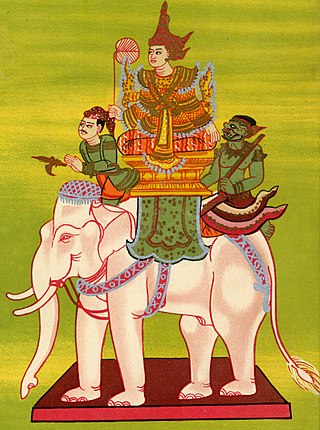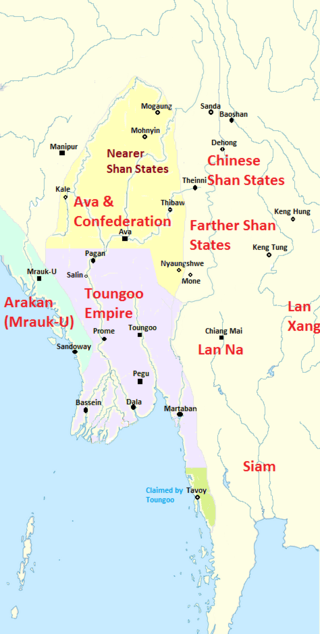
The Shan States were a collection of minor Shan kingdoms called muang whose rulers bore the title saopha in British Burma. They were analogous to the princely states of British India.

Mingyi Nyo was the founder of the Toungoo dynasty of Burma (Myanmar). Under his 45-year leadership (1485–1530), Toungoo (Taungoo), grew from a remote backwater vassal state of Ava Kingdom to a small but stable independent kingdom. In 1510, he declared Toungoo's independence from its nominal overlord Ava. He skillfully kept his small kingdom out of the chaotic warfare plaguing Upper Burma. Toungoo's stability continued to attract refugees from Ava fleeing the repeated raids of Ava by the Confederation of Shan States (1490s–1527). Nyo left a stable, confident kingdom that enabled his successor Tabinshwehti to contemplate taking on larger kingdoms on his way to founding the Toungoo Empire.
Nyaungyan Min was king of the Toungoo dynasty of Burma (Myanmar) from 1599 to 1605. He is also referred to as the founder of the restored Toungoo dynasty or Nyaungyan dynasty for starting the reunification process following the collapse of the First Toungoo Empire.

Thihathu of Ava was king of Ava from 1421 to 1425. Though he opportunistically renewed the Forty Years' War with Hanthawaddy Pegu in 1422, Thihathu agreed to a peace treaty with Prince Binnya Ran in 1423. His subsequent marriage to Ran's sister Princess Shin Saw Pu helped keep the peace between the two kingdoms when Ran became king of Pegu in 1424.
Mohnyin Thado was king of Ava from 1426 to 1439. He is also known in Burmese history as Mohnyin Min Taya after his longtime tenure as the sawbwa of Mohnyin, a Shan-speaking frontier state. He founded the royal house of Mohnyin that would rule the kingdom until 1527.
Minye Kyawswa I of Ava (Burmese: မင်းရဲကျော်စွာ, pronounced[mɪ́ɰ̃jɛ́tɕɔ̀zwà]; also known as Hsinbyushin Minye Kyawswa Gyi was king of Ava from 1439 to c. 1442. In less than three years of rule, the second king from the royal house of Mohnyin had recovered four major former vassal states of Ava: his native Mohnyin, Kale, Taungdwin and Toungoo, and was about to capture a fifth, Mogaung, which was achieved shortly after his death. Despite the successes farther afield, his attempt to capture the closer districts of Pinle and Yamethin failed.
Narapati I of Ava was king of Ava from 1442 to 1468. In the early years of his reign, this former viceroy of Prome (Pyay) was forced to deal with raids from the Shan State of Mogaung as well as the Ming Chinese intrusions into Avan territory (1444–1446). In the wake of renewed Chinese determination to pacify the Yunnan frontier region, Narapati was able to maintain Ava's control of northern Shan States of Kale and Mohnyin, and gained allegiance of Thibaw. However, he continued to have trouble with Toungoo which was in revolt between 1451 and 1459. One of his grandsons made an attempt on his life in June 1467. The king fled Ava for Prome and died there in July 1468.
Thihathura of Ava was king of Ava from 1468 to 1480. He was the last king of Ava who was able to hold on to the increasingly fractious kingdom in its entirety. Soon after succeeding his father Narapati, the new king had to put down a rebellion in Toungoo (Taungoo) in 1470, and suppressed an insurrection by his brother the lord of Prome (Pyay), whom the king pardoned. He gained submission of the eastern Shan state of Yawnghwe, and quelled a potential rebellion in the northern Shan states of Mohnyin and Mogaung. He was succeeded by his son Minkhaung II.
Minkhaung II was king of Ava from 1480 to 1501. His 20-year reign was the beginning of the decline of Ava's hold on Upper Burma. Yamethin, a region to the east of Ava, revolted upon Minkhaung's accession to the Ava throne and stayed independent throughout Minkhaung's reign. The southern regions of Prome and Tharrawaddy revolted in 1482, and also stayed independent. By the mid-1490s, the Shan states of Mohnyin, Mogaung, Momeik and Kale (Kalay) had also broken away, and begun raiding northern Ava territories. Minkhaung increasingly came to rely on Mingyi Nyo, the Viceroy of Toungoo, for military assistance. By the end of his reign, Toungoo was equally powerful as its nominal overlord Ava.
Shwenankyawshin Narapati was king of Ava from 1501 to 1527. His reign saw the disintegration of the Ava Kingdom. He spent much of his reign fighting back the attacks from the Confederation of Shan States. But his efforts ultimately proved unsuccessful. The king died fighting while defending his capital from Confederation attacks, after which Ava Kingdom was taken over by the Confederation.
Mobye Narapati also Sao Hso Kaw Hpa of Mong Pai was the penultimate king of Ava who reigned from 1545 to 1551. The ethnically Shan king ruled as the disputed leader of the Confederation of Shan states that had ruled Ava since 1527. He ended the seven years' war with Toungoo as soon as he came to power. Throughout his six years of reign, he faced an active rebellion by Sithu Kyawhtin, who was supported by the Shan state of Mohnyin. He controlled only a rump state, east of the Irrawaddy and north of Pagan (Bagan). After he was finally driven out of Ava (Inwa) in October 1551, he fled south to Pegu (Bago) where he was given protection by King Bayinnaung of Toungoo Dynasty. He lived out his years at Pegu.
Sithu Kyawhtin was the last king of Ava from 1551 to 1555. He came to power by overthrowing King Narapati III in 1551, the culmination of his six-year rebellion (1545–1551) with the support of the Shan state of Mohnyin.
Thohanbwa was king of Ava from 1527 to 1542. The eldest son of Sawlon of Mohnyin was a commander who actively participated in Monhyin's numerous raids of Ava's territories in the first quarter of 16th century. In March 1527, the ethnically Shan king was appointed king of Ava by Sawlon after Mohnyin-led confederation of Shan States defeated Ava in 1527. After Sawlon was assassinated in 1533, Thohanbwa became the undisputed king of Ava as well as chief of Mohnyin. However, he was not immediately accepted by other chiefs as the leader of the confederation.
Hkonmaing was king of Ava from 1542 to 1545. The saopha of the Shan state of Onbaung–Hsipaw was elected by the Ava court to the Ava throne in 1542, by extension the leader of the Confederation of Shan States, despite strenuous objections by the House of Mohnyin. He was accepted as the leader by other Confederation leaders only because the Confederation was in the middle of a serious war with Toungoo Dynasty. After the Confederation's failed military campaigns in 1543–45 that resulted in the loss of Central Burma, Hkonmaing lost the support of Sawlon II of Mohnyin. He died in 1545 while fighting a Mohnyin-backed rebellion by Sithu Kyawhtin.
Thado Minsaw of Prome Tai name Hso Ming Hpa was the founder of Prome Kingdom, and reigned the minor kingdom from 1482 to 1527. In 1524, he entered into an alliance with the Confederation of Shan States, and participated in the 1525 sack of Ava (Inwa).
Bayin Htwe Tai name Hso Yam Hpa (သိူဝ်ယႅမ်ႉၾႃႉ) was king of Prome (Pyay) from 1527 to 1532. His small kingdom, founded by his father Thado Minsaw in 1482, was conquered by the Confederation of Shan States in 1532, and he was taken prisoner to Upper Burma. He was later released, and returned to Prome only to be refused entry by his son Narapati. Bayin Htwe died at the outskirts of Prome (Pyay) in mid 1533.
The Prome Kingdom also known as Pyay Kingdom was a kingdom that existed for six decades between 1482 and 1542 in present-day central Burma (Myanmar). Based out of the city of Prome (Pyay), the minor kingdom was one of the several statelets that broke away from the dominant Ava Kingdom in the late 15th century. Throughout the 1520s, Prome was an ally of the Confederation of Shan States, and together they raided Avan territory. After Ava fell to the Confederation armies in 1527, Prome itself became a tributary of the Confederation in 1532. In the late 1530s, Prome became ensnarled in the Toungoo–Hanthawaddy War (1534–1541). Despite military assistance from the Confederation and the Mrauk U Kingdom, the small kingdom fell to the Toungoo (Taungoo) forces in 1542.

The Toungoo–Ava War (1538–1545) was a military conflict that took place in present-day Lower and Central Burma (Myanmar) between the Toungoo Dynasty, and the Ava-led Confederation of Shan States, Hanthawaddy Pegu, and Arakan (Mrauk-U). Toungoo's decisive victory gave the upstart kingdom control of all of central Burma, and cemented its emergence as the largest polity in Burma since the fall of Pagan Empire in 1287.
Hkonmaing or Hso Tamla was saopha of the Shan principality of Onbaung–Hsipaw in what is now Myanmar. He was the only main ally of King Narapati II of Ava in the latter's 25-year struggle against the Mohnyin-led Confederation of Shan States, Prome and Toungoo. After Ava's fall, he became a member of the Confederation. He died during or shortly after his participation in the Confederation's 1542 campaign against Toungoo Dynasty. His son, also named Hkonmaing, and grandson Narapati III became kings of Ava.
Minye Kyawhtin was a pretender to the Ava throne from 1426 to 1459. The eldest son of Crown Prince Minye Kyawswa, Minye Kyawhtin raised a long-running rebellion against King Mohnyin Thado and his successors, kings Minye Kyawswa I and Narapati I of Ava.



